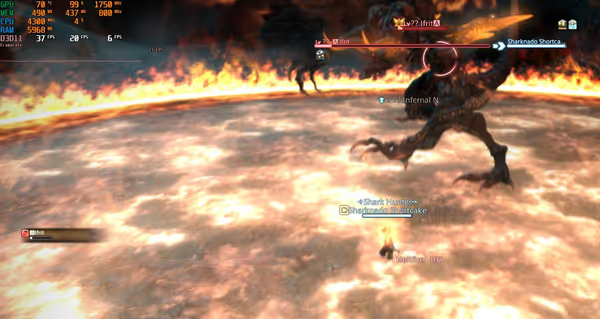Final Fantasy XIV on integrated graphics
Some laptops or small PCs offer only integrated graphics cards without the option of installing a dedicated one. They offer quite low performance but some of them do allow for light gaming, including FF14.
Comparison of SoCs with integrated graphics:
Lets start with comparing some integrated graphics:

This is a mixed CPU + iGPU comparison as each of tested products have different CPU cores and different iGPU block. Athlon 200GE is a very basic dual core with small Vega 3 iGPU. Scores are low (for 2133CL14 and 2666CL20). Ryzen 2200G is bit bigger APU from the same family and with four cores it scores way higher. Ryzen 4650G is a Zen 2 desktop APU with Vega 7 iGPU and six cores. Ryzen 4800U is a laptop low power 10W eight core CPU with Vega 8 iGPU. Due to lower power it scores below the desktop part.
Intel also has integrated graphics but only some specifics parts have a bigger one allowing actual light gaming. That would be quad core mobile Tiger Lake chips like i5-1135G7 and i7-1165G7 - they have high clocks/IPC and really good iGPU similar to Vega 8 in Ryzen 4800U. We are also expecting new Intel and AMD laptop chips (ADL-P and Rembrandt) to be announced at CES 2022 in January so somewhere in Q1-Q2 of 2022 you should have a wider range of lightweight laptops capable of playing FF14 on low/medium settings.
Laptop - Lenovo IdeaPad 5 14ARE05 with Ryzen 4800U
We got some score numbers but what's playable and what is not? Most of those APUs do not provide a good playable experience at 1080p resolution. Only the stronger and newer parts can be used. Lets take a look at a laptop - Lenovo IdeaPad 5 14ARE05 with Ryzen 4800U and 16GB of 3200CL22 RAM:


This laptop offers around 30 FPS in the benchmark. First scenes (intro, city and mass combat) don't really improve on lower resolution, likely due to a CPU bottleneck. Open world and smaller trial encounter do improve by using lower resolution. If you have a system with iGPU you can try lowering the resolution to get much better experience. If the screen isn't big it shouldn't really be that noticeable.
If we launch the game (Shadowbringers) the FPS is lower, especially in tightly populated city:

And as mobile devices have in common - the performance will be lower when on battery - depending on given laptop vendor settings:

Desktop APU - Ryzen 4650G
Ryzen 4650G as a desktop part uses more power to sustain higher clocks and frequencies which then allows for bit better FPS while being very similar to Ryzen 4800U:



iGPU RAM performance scaling
Integrated graphics performance will be linked to system RAM performance. Dedicated graphics cards use their own specialized fast memory while integrated ones have to settle for much slower system memory. For desktop we have some options of picking better RAM while on laptops things are much limited. For Ryzen 4650G it looks like so:

The game runs fine with 8GB of RAM - but that's for a clean Windows install with only the game running. Single channel RAM is hit super hard by the Final Fantasy Endwalker benchmark. It seems like the game needs a lot of bandwidth. Desktop APUs can use quite fast RAM so if you have such PC you could get few more FPS with a good DDR4 RAM kit.
On laptops DDR4 DIMMs follow only JEDEC specs so we get up to 3200CL22. There are some differences between kits (x8 or slower x16 timings) but you can't push it as on desktop. It's worth noting that few Ryzen and quite a lot of Intel Tiger Lake laptops will use LPDDR4X-4266MT/s RAM that will be soldered on the laptop motherboard (so no upgrades). This RAM performs better and allows Tiger Lake iGPU to perform noticeably better as well.
In 2022 we will start seeing laptops with DDR5 memory which will be faster than DDR4 (and also LPDDR5) which could give a performance boost in future iGPU laptops.
FPS versus playable experience
30 FPS is regarded as the minimum for acceptable gaming experience. Average/current framerate doesn't paint the whole picture and can be misleading when comparing experiences between players. To have a good experience even at low framerate you want that framerate to be consistent. If each frame is rendered in 1/30 of a second then you will get 30 frames per second. But if every n-th frame takes way longer you will instantly notice it in game as stutter - like if the game paused for a moment.
To showcase frametime consistency benchmarks publish frametime charts or pick 1%/0.1% of slowest frames from benchmark run and showcase them as FPS. You want a frametime chart that is quite even without drops and you want 1%/0.1% FPS to be close to average FPS.
Here are some short frametime charts made on 4650G in the game:




Crystarium is quite smooth (not many people etc) while in Limsa you can see more aggressive changes to the frametimes due to lots of people around. Some frames shoot up which then could be perceived as stutter (and going through so many players isn't fast/smooth on this system).
Shiva and Ifrit perform better as the instance is smaller and you never get a lot of people there. This is most important as you want to see and react to encounter mechanics quickly. I've tested the Lenovo IdeaPad 5 14ARE05 laptop and even when average FPS was 25-30 it was still responsive and allowing doing the mechanics, even when a lot of particle effects shows up.
Comment article